Utility Broadband the TRE-FOR Way
How a small utility co-op is boosting Danish broadband: * Ethernet & FTTH * Open network * Customer/provider portal
August 10, 2006

The separation of services and networks is considered by many to be fundamental to the future of telecom, and one of the reasons for this is demonstrated in spades by a municipal network project in Denmark.
The project in question brings a new meaning to the term “quadruple play” in that the developer, a cooperative called TRE-FOR, is adding broadband connectivity to the three other utilities – electricity, gas, and water – it already delivers to a community of about 300,000 customers.
TRE-FOR has crafted a role for itself as a middleman between its customers and service providers. It’s rolling out fiber-to-the-home (FTTH) and Ethernet infrastructure, offering customers a self-service portal for them to order services, and providing a platform that makes it easy for third parties to provide those services.
The bottom line is that TRE-FOR isn’t taking on any of the risky business of guessing what applications will prove a hit with its customers. It’s still in the utility business, where investments can be amortized over a long period, and thus it's able to keep a lid on costs. At the same time, it’s created an environment that encourages innovation and competition among service providers so that its customers (who are also its shareholders) get a wide choice of offerings at low prices.
This report steps through the project in detail, drawing lessons from the experiences of TRE-FOR and its suppliers, which include Cisco Systems Inc. (Nasdaq: CSCO) and Unisys Corp. (NYSE: UIS). Here’s a hyperlinked contents list:
Page 3: The TRE-FOR Network & Services
Page 4: The Ethernet Design
Webinar
This report is based on a Webinar, TRE-FOR: Denmark's Pioneering Municipal Network Project, moderated by Simon Hill, Events Editor, Light Reading, and sponsored by Cisco Systems Inc. (Nasdaq: CSCO) and TRE-FOR Bredbånd A/S . An archive of the Webinar may be viewed free of charge by clicking here.
Related Webinar archives:
About the Author
— Tim Hills is a freelance telecommunications writer and journalist. He's a regular author of Light Reading reports.
Next Page: Business Model & Market Considerations
TRE-FOR is a multi-utility (for water supply, district heating, electricity – and now broadband telecom) serving an area of about 28km radius in East Jutland, Denmark (see Figure 1). There are three principal towns – Fredericia, Kolding, and Vejle – and about 300,000 customers. Not only is the local population relatively concentrated, but it is among the country’s wealthiest – potentially good omens for a muni-broadband project.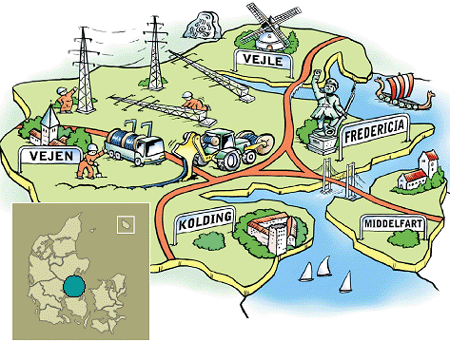 The company is organized as a cooperative and is essentially owned by its customers, who can be elected to the 115-member Stakeholders’ Committee, which, among other things, helps to set strategic priorities and directions.
The company is organized as a cooperative and is essentially owned by its customers, who can be elected to the 115-member Stakeholders’ Committee, which, among other things, helps to set strategic priorities and directions.
“It is the Stakeholder Committee that has decided to run FTTH,” says Arne Rahbek, Head of Communication at TRE-FOR. “Of course, having a concentrated area with a lot of customers makes it easier and cheaper to develop FTTH. We have a highly effective utility company with more than 100 years of experience. Broadband is a natural fourth utility.”
He acknowledges that there are obvious competitors – not least the incumbent Danish telco, TDC A/S (Copenhagen: TDC) – but points out that TRE-FOR is a shareholder in the new broadband utility, TRE-FOR Bredbånd A/S, and works on the principle that all earnings must be used for investments in the new company.
“The broadband utility is therefore about accessibility, quality, and price. We don’t pay any stockholders any money. The money we earn goes back to the customers,” he says. “We are not just another telephone company, because we want other service providers to do the telephony stuff on our network.”
The FTTH decision was taken in November 2004 and rested on a number of core principles:
Broadband for everybody – The future IP network must be available for all, with no connection fee. This was a main issue for the committee to decide.
Implement an equal-access network – With access for all service providers, and therefore no de facto monopoly over services.
Use core competences in effective utility delivery – TRE-FOR Bredbånd does not compete with service providers using the network.
Create competitive advantage for the local community – By making the area attractive to new citizens. It is situated in the middle of Denmark, which is one of the most advanced and high-technology countries in the world and needs to keep that status.
Primary connectivity will be FTTH – Wireless may be used as an alternative.
Cooperation with all who want to cooperate – Rollout to start in the city of Fredericia in 2005. All major cities covered by 2008, and complete coverage by 2012.
Use external financing resources – TRE-FOR has a capital foundation of €225 million (US$288.6 million).
Next Page: The TRE-FOR Network & Services
The TRE-FOR network is based on a core-plus-aggregation layer. The core is a dual 5-node redundant IP/MPLS backbone, shown in Figure 2. This uses Cisco 7600 Series routers with 10-Gigabit Ethernet interfaces. Cisco 7606 routers support the backbone itself, while dual Cisco 7609 routers, fully meshed by 10-Gigabit Ethernet, provide the main points of presence (POPs), as shown in Figure 3. Overall, the 7600 Series routers should scale to more than 10 million subscribers in a live network.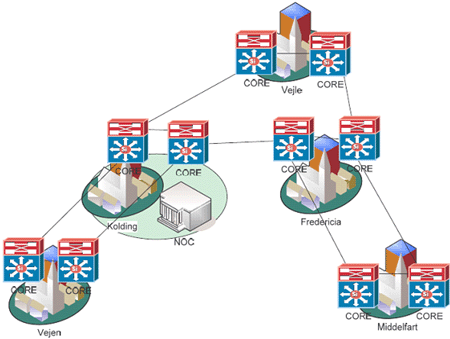
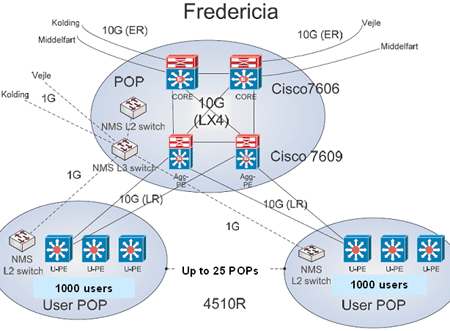 “10-Gbit/s connectivity within the core could be scaled higher in future,” says Gloria Formenti, Solution Manager for Cisco Systems EMEA. “But, for the moment, we believe that 10-GigE will be able to handle a number of TV channels – 150 video channels, say. But, definitely, we can later introduce another layer with DWDM capability.”
“10-Gbit/s connectivity within the core could be scaled higher in future,” says Gloria Formenti, Solution Manager for Cisco Systems EMEA. “But, for the moment, we believe that 10-GigE will be able to handle a number of TV channels – 150 video channels, say. But, definitely, we can later introduce another layer with DWDM capability.”
The IP/MPLS core is designed to implement video-optimized asymmetric networking. Only bandwidth needed across the core and the distribution network for downstream and upstream services, such as Pay Per View and Video On Demand, will be configured.
The last-mile FTTH access infrastructure uses Cisco Catalyst 4500 Series Ethernet switches, dual-homed to the main POPs via 10-Gigabit Ethernet ports that offer pluggable transceivers for an extended reach of up to 80km. According to Cisco, the 4510R used in the TRE-FOR network is a new access switch optimized for the FTTH market. It offers a high availability in supporting a 1+1 redundant supervisor engine with a subsecond failover time, and has 8 slots that can be equipped with 48-port linecards. Singlemode single fiber can be used to optimize the use of fiber down to the building or apartment.
Access switches are located in central offices or in the basements of multitenant units (MTUs), and the last drop can be via Cat 5 cable, multimode fiber (MMF), singlemode fiber (SMF), or Ethernet Over VDSL (EOVDSL).
Each central office serves 10x1000 users, and the central offices are distributed into 25-user POPs. The access layer is a Layer 2 solution, and every household will be on its own protected VLAN. The supervisor engine of the Catalyst 4510R ensures nonblocking switching for a converged data, voice, and video environment.
Services and Service Provisioning
Easy and cost-effective service provisioning is a crucial part of the TRE-FOR approach. It’s crucial because the basis of this utility-broadband model is that TRE-FOR does not provide many real services itself – essentially just the fiber connection and the underlying broadband connectivity. So there has to be a foolproof way for customers (both residential and business) and third-party service providers to find each other and communicate – a sort of telecom dating agency – and for service providers to interact with TRE-FOR Bredbånd itself to set up customers’ services. And it needs to be cheap for TRE-FOR to run, because much of its income will be derived indirectly from revenue sharing with service providers.
TRE-FOR Bredbånd’s only direct revenues come from providing basic fiber connectivity (about €13 per month residential subscription) and, if the subscriber takes them, from its own Internet service (about €20 per month including fiber connectivity for 1 Mbit/s, €40 for 10 Mbit/s, and €80 for 20 Mbit/s – the latter two including some extra bundled products). Currently, fiber connection and installation are free, but they will later be charged at €600 (US$770).
Customers will also need a router, which they can buy for €100 or rent for €5 per month, unless they opt for the 20-Mbit/s connection where the router is part of the bundle. A set-top box is included when broadband TV is ordered, and additional set-top boxes can be rented or bought.
Business subscribers have a different pricing model and are charged for any trenching and civil works (residential subscribers are not); they also have further types of product available, including QOS.Service provisioning uses a self-service Web portal developed by Scanweb A/S , as illustrated on the left of Figure 4. The basic functions of the portal are order handling, trouble ticketing, and customer relationship management (CRM).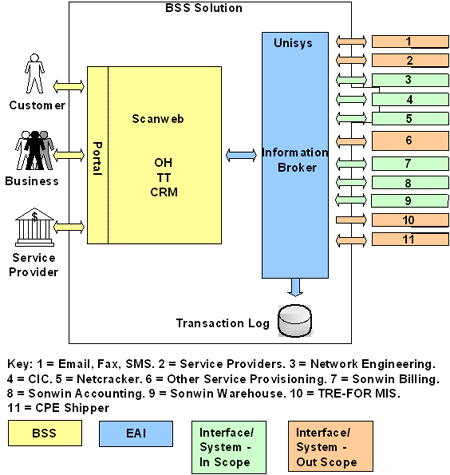 “If we didn’t do it like this, we would have a lot of people involved in provisioning,” says TRE-FOR’s Rahbek. “We intend to have about 10 to 15 people – if we had not done it this way, we would have had about 100 people. So a lot of money is involved in having the right solution.”
“If we didn’t do it like this, we would have a lot of people involved in provisioning,” says TRE-FOR’s Rahbek. “We intend to have about 10 to 15 people – if we had not done it this way, we would have had about 100 people. So a lot of money is involved in having the right solution.”
A second, crucial system lies behind the Scanweb portal, with which it interacts. This is the information broker from Unisys Corp. (NYSE: UIS), which provides and controls the equal-access interface (EAI) between the business support system (BSS) and the various operations support systems (OSSs) – for example, network engineering or the Triple Play Service Provisioning System from Netcracker Technology Corp.
Next Page: The Ethernet Design
A key early decision in the network and service design was to plump for a point-to-point Ethernet architecture to run over the FTTH network. The basic motivation for this was that it allows dedicated per-user bandwidth that is potentially unlimited. So, currently, the TRE-FOR network supports up to 100 Mbit/s per subscriber (Fast Ethernet), but the same fiber could in the near future support up to 1 Gbit/s (Gigabit Ethernet), with no change in architecture.
“This is vital because it is very difficult to predict future bandwidth requirements,” says Cisco’s Formenti. “Given the introduction of high-definition video, we can assume that real-time video streaming will be the dominant service at home. And video downloads will also bring a new requirement for ultra-high-speed communications.”
She points out, too, that a point-to-point Ethernet architecture allows the same network to be used for both residential and business customers. Other reasons for using the architecture are:
Availability of low-cost residential gateways and other Ethernet CPE
Very flexible interconnection speeds between access and aggregation switches by using not only Gigabit Ethernet but also 10-Gigabit Ethernet and, in future, DWDM
Ease of dual-home of access switches for resiliency
Figure 5 shows the structure of a typical point-to-point Ethernet deployment as envisaged by Cisco Systems. There are three functional layers. The first is the network core backbone, built with high-performance routing or switching nodes interconnected by 10-Gigabit Ethernet links. MPLS gives the core reliable backbone connectivity between devices through its control plane, and provides sophisticated management mechanisms and traffic load balancing. The latter feature is very relevant, because consumer bandwidth demand is growing very quickly, and more content capacity – unicast and broadcast – needs to be allocated in the core network. This traffic is enabled over an optimized infrastructure that provides 10-Gigabit Ethernet with nonblocking switching capability.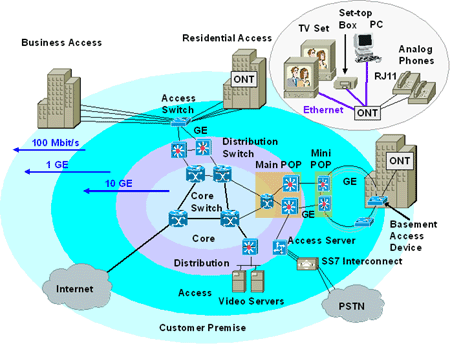 The aggregation layer provides scaling to large numbers of access devices through efficient traffic aggregation, traffic multiplexing, congestion management, and local switching for Internet services.
The aggregation layer provides scaling to large numbers of access devices through efficient traffic aggregation, traffic multiplexing, congestion management, and local switching for Internet services.
At the access layer there are multiple options, and the architecture addresses both the business customers, with an Internet-to-the-business model, and the residential customer. The TRE-FOR FTTH network uses a switched hub-and-spoke topology, but other options are to terminate fiber in MTU basements and reuse existing copper cabling within the building, and, in low-density areas, to implement switched Gigabit Ethernet rings at eventually 1 or 10 Gbit/s.
Besides the basic Ethernet architecture and topology, there are many other considerations that need to be addressed to achieve acceptable levels of, for example, QOS, security, and reliability. These, and the solutions used in the TRE-FOR network, include:
Address management – Uses a mix of public and private IP addresses, assigned by DHCP
Subscriber identification required for access control / policy enforcement security / traceability billing – This can be done via MAC addresses, or via user login using SSG (Service Selection Gateway) or a portal, or via support of DHCP Option 82
User isolation and access security – Achieved by using VLANs in all architectures, private VLAN edge, port security, local proxy ARP, DHCP snooping, dynamic ARP inspection, IP source guard against DOS attacks
End-to-end QOS – Based on DiffServ model, traffic marking, per-service policing, per-class queuing, and congestion avoidance
Overall, of course, there must be high standards of network resilience, and, in a triple-play network, video delivery over IP requires efficient multicast distribution.
Next Page: The Self-Service Portal & Equal-Access Network
The dominant characteristic of TRE-FOR’s utility broadband is that it is an equal-access network for third-party service providers, with an automated self-service Web portal acting as the customer and service-provider front-end. Producing systems to implement this has been a major part of the project.
As shown already in Figure 4, the equal-access capability is supported by the Unisys-designed equal-access interface (EAI) system, which provides the middleware glue between the Web portal and the various network OSSs and TRE-FOR business systems. Implementing the EAI required TRE-FOR and Unisys to analyze in great detail all possible business and network interactions that utility broadband would involve. Figures 6 and 7 show a couple of the simpler examples – for subscription signup and service-provider IP telephony subscription.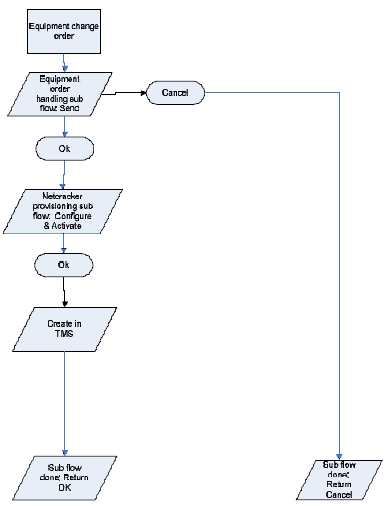
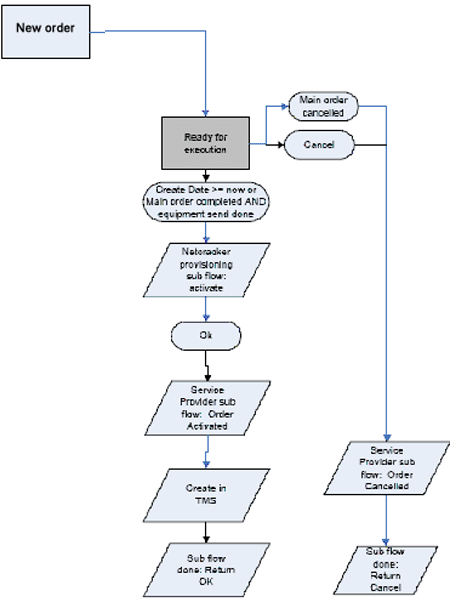 This analysis was done formally through using the Unisys 3D Visible Enterprise Blueprinting (3DVE) approach, a systematic methodology that can model a telecom (and other) business into four layers:
This analysis was done formally through using the Unisys 3D Visible Enterprise Blueprinting (3DVE) approach, a systematic methodology that can model a telecom (and other) business into four layers:
Layer 1 essentially defines strategies – competitive landscape, business objectives, and metrics for new service and market strategies.
Layer 2 details the elements in key business processes and how they interact with each other.
Layer 3 analyzes the applications that support the business – CRM, service assurance, network management, provisioning, and billing.
Layer 4 maps how the infrastructure supports the business.
Using the Portal
When TRE-FOR Bredbånd is ready to serve an area, it sends a personalized letter to utility customers to inform them that it is now possible for them to get FTTH. The letter provides customers with a name and installation number for first-time registration use at the self-service portal, www.profiber.dk. When registered, the portal gives the customer a user ID and password for use in ordering new services and products, or changing existing ones – such as renting or buying a router, or changing the speed of their Internet access.
It’s worth pointing out that apparently trivial marketing decisions and gimmicks can have a disproportionate effect on self-service portals, as TRE-FOR discovered.
“If you go from the 10- to 20-Mbit/s speed, it is possible to have a router for free,” says TRE-FOR’s Rahbek. “That is a little complicated, because when you change speeds the system must know that you are going to have the router for free – that was a challenge for us [when we first did it].”
Services that can be selected and configured through the portal currently include:
Fiber connectivity only
Internet access at 1, 10, or 20 Mbit/s (symmetrical)
Internet services such as mailbox, photo album, archiving, Web hosting, and private content management systems (from the Danish service provider TM Networks )
VOIP (for example, from the Danish service provider debitel)
IPTV, with a range of options including basic and extra content packages, language choice, and VOD (from the Danish triple-play service provider ComX Networks A/S )
TRE-FOR, despite effectively taking an arm’s-length approach to service provisioning, does work with the independent service providers to allow them to develop further offerings or enhancements. For example, debitel offers a Profiber Safetalk voice option for an additional €1.5 per month for local calls to be kept within TRE-FOR’s fiber network, which therefore enjoy a higher QOS than calls routed through the public Internet.
An obvious issue for TRE-FOR is to attract service providers to its network.
“We want all the service providers we can get, if they have the right solutions for our customers,” says Rahbek. “We would really like to have more than one service provider for each product, because that gives some competition, which is advantageous for the customers, of course.”
The company is moving this way, as it currently has three VOIP service providers, for example. But Rahbek does concede that there are challenges with service providers: Many of the service providers in Denmark are quite new and are therefore still small operations, which may reduce their attractiveness to potential subscribers.
You May Also Like


_International_Software_Products.jpeg?width=300&auto=webp&quality=80&disable=upscale)







